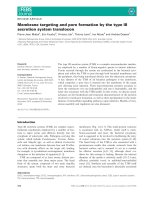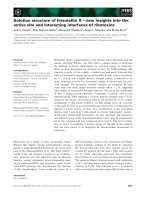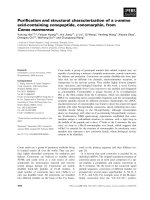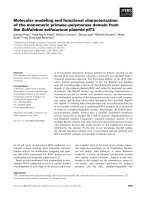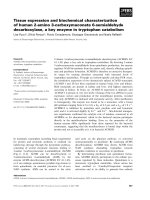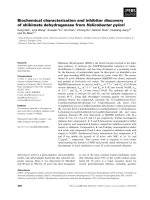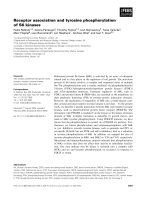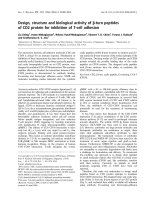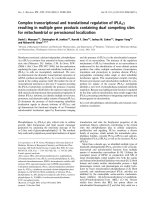Báo cáo khoa học: Solution structure and backbone dynamics of the XPC-binding domain of the human DNA repair protein hHR23B docx
Bạn đang xem bản rút gọn của tài liệu. Xem và tải ngay bản đầy đủ của tài liệu tại đây (547.87 KB, 10 trang )
Solution structure and backbone dynamics of the
XPC-binding domain of the human DNA repair protein
hHR23B
Byoungkook Kim
1,
*, Kyoung-Seok Ryu
2,
*, Hyun-Jin Kim
1
, Sung-Jae Cho
1
and Byong-Seok Choi
1
1 Department of Chemistry, and National Creative Research Initiative Center for the Repair System of Damaged DNA, Korea Advanced
Institute of Science and Technology, South Korea
2 Korea Basic Science Institute, Daejon, South Korea
Nucleotide excision repair (NER) is an important
pathway for the removal of DNA lesions caused by
diverse environmental factors, such as UV irradiation
and chemical modifications [1,2]. There are two human
homologs (A and B) of the yeast Rad23 protein
(hHR23A and hHR23B), both of which can form a
complex with the xeroderma pigmentosum group C
protein (XPC) [1,3]. Recent in vitro and in vivo studies
point to a role for the XPC–hHR23B complex as the
initiator of global genomic NER [1,4]. Although the
precise functions performed by hHR23A and hHR23B
alone in human NER have not yet been determined,
Keywords
hHR23B; nucleotide excision repair; stress-
inducible; structure; xeroderma
pigmentosum group C protein
Correspondence
B S. Choi, Department of Chemistry and
National Creative Research Initiative Center
for Repair System of Damaged DNA, Korea
Advanced Institute of Science and
Technology, Yusong-Gu, Gusong-Dong 373-1,
Daejon 305-701, South Korea
Fax: +82 42 869 2810
Tel: +82 42 869 2868
E-mail:
*Byoungkook Kim and Kyoung-Seok Ryu
contributed equally to this work
Note
The atomic coordinates of the bundle of 20
conformers have been deposited in the
RCSB Protein Data Bank with entry code
1PVE
(Received 9 November 2004, revised
4 March 2005, accepted 17 March 2005)
doi:10.1111/j.1742-4658.2005.04667.x
Human cells contain two homologs of the yeast RAD23 protein, hHR23A
and hHR23B, which participate in the DNA repair process. hHR23B hou-
ses a domain (residues 277–332, called XPCB) that binds specifically and
directly to the xeroderma pigmentosum group C protein (XPC) to initiate
nucleotide excision repair (NER). This domain shares sequence homology
with a heat shock chaperonin-binding motif that is also found in the stress-
inducible yeast phosphoprotein STI1. We determined the solution structure
of a protein fragment containing amino acids 275–342 of hHR23B (termed
XPCB–hHR23B) and compared it with the previously reported solution
structures of the corresponding domain of hHR23A. The periodic position-
ing of proline residues in XPCB–hHR23B produced kinked a helices and
assisted in the formation of a compact domain. Although the overall struc-
ture of the XPCB domain was similar in both XPCB–hHR23B and
XPCB–hHR23A, the N-terminal part (residues 275–283) of XPCB–
hHR23B was more flexible than the corresponding part of hHR23A. We
tried to infer the characteristics of this flexibility through
15
N-relaxation
studies. The hydrophobic surface of XPCB–hHR23B, which results from
the diverse distribution of N-terminal region, might give rise to the func-
tional pleiotropy observed in vivo for hHR23B, but not for hHR23A.
Abbreviations
hHR23B, human homolog B of yeast Rad23; NER, nucleotide excision repair; RMSD, root mean square deviation; STI1, stress-inducible,
heat shock chaperonin-binding motif; UBA, ubiquitin-associated domains; UbL, ubiquitin-like domain; XPC, xeroderma pigmentosum group C
protein; XPCB, XPC binding.
FEBS Journal 272 (2005) 2467–2476 ª 2005 FEBS 2467
many reports suggest that these proteins stabilize the
XPC protein by protecting it from 26S proteasome-
dependent protein degradation [5–7]. Another bio-
chemical analysis of the damage-recognition process in
NER revealed that hHR23B is necessary for XPA ⁄
replication protein A-mediated displacement of the
XPC–hHR23B complex from damaged DNA [8].
Both hHR23A and hHR23B have four well-defined
functional domains (Fig. 1A). These include an N-ter-
minal ubiquitin-like (UbL) domain, the XPC-binding
domain, and two ubiquitin-associated domains (UBA1
and UBA2) [9,10]. The UbL domain has a high bind-
ing affinity for polyubiquitin binding site 2 of the
human S5a protein, which is supposed to serve as a
shuttle delivering polyubiquitinated, degradable protein
substrates to the proteasome [10]. The UBA domains
occur in many enzymes involved in the ubiquitination
pathway and in cell-cycle check points [5,11]. It also
has been shown recently that the intramolecular inter-
action between the UbL and UBA domains of
hHR23B may regulate NER by modulating the pro-
teolysis of XPC [12,13].
The XPC-binding domain of hHR23B (residues
277–332, referred to herein as XPCB–hHR23B) houses
an XPC-stimulation activity that functions in a manner
similar to that of full-length hHR23B; this activity par-
ticipates in DNA damage discrimination in vitro and
in the enhancement of cell survival in vivo [9]. From
the amino acid sequence, Masutani et al. [9] showed
that the XPC-binding domain of hHR23B has a partly
repetitive character [that is, it contains various versions
of the sequence (P)QLLQQ(I)] and a highly amphi-
pathic nature, which is evident when the domain is
represented as a helical wheel [9]. XPC-binding
domain-like sequences are also found in protein
linking IAP with cytoskeleton (PLIC), which also has
both UbL and UBA domains [14]. Consensus motifs
from proteins with XPC-binding domain-like sequen-
ces are shown in Fig. 1B. It is interesting that the
XPC-binding domain has been classified as a heat
shock chaperonin-binding motif, which is also found in
the stress-inducible phosphoprotein STI1 [15,16]. The
presence of sequence similarity between the XPCB
domain and STI1 is not surprising, because XPC is also
induced by a kind of cellular stress (i.e. DNA damage).
Studies have also suggested that hHR23B has more
diverse in vivo functions than hHR23A. For example,
only hHR23B was codetected with XPC protein during
the affinity fractionation of mammalian crude extract,
using an immobilized glutathione-S-transferase (GST)–
S5a fusion protein [17]. S5a can bind to both polyubi-
quitinated proteins and the N-terminal ubqiuitin-like
domain of hHR23A ⁄ B [18]. This might occur because
only a small fraction of cellular hHR23A exists in a
complex with XPC [7]. Experiments with knockout
mice that carry a homozygous deficiency in either the
mHR23A or mHR23B gene showed that these two pro-
teins are functionally redundant in terms of response
to DNA damage by UV light. The XPC protein was
not detected in the double knockout cell line, but
could be detected after treatment with a proteasome
inhibitor. It is interesting that only the mHR23B
knockout mouse showed defects in postnatal growth,
suggesting that mHR23B may have functions beyond
those related to XPC and DNA repair [19].
Here, we report the three-dimensional solution struc-
ture of the XPCB–hHR23B (275–342) fragment
(XPCB–hHR23B), which contains the XPC interaction
domain, and compare this with the recently reported
structure of XPCB–hHR23A [13,20]. Both overall
A
B
Fig. 1. Proteins with STI1-homologous domain and the sequence alignment of the XPCB domain with its homologs. (A) Domain presenta-
tions of the STI1-homologous proteins, showing the UbL (ubiquitin-like), UBA (ubiquitin associated), STI1 (stress inducible) and TPR (tetratrico
peptide repeat) domains. (B) Multiple sequence alignments of the XPCB domains of hHR23B and hHR23A with other STI1-homologous
domains from yeast STI1 and DSK2, and from human PLIC2 were obtained from a simple modular architecture research tool (
SMART)
[16]. The Pro residues are indicated in bold.
Dynamic structure of XPC-binding domain of hHR23B B. Kim et al.
2468 FEBS Journal 272 (2005) 2467–2476 ª 2005 FEBS
structures are similar, but the N-terminal part (275–
283) of XPCB–hHR23B is more flexible than that of
hHR23A.
15
N-Heteronuclear relaxation analyses were
performed with XPCB–hHR23B to gain precise infor-
mation concerning the flexibility of the NH vectors
along the peptide chain. We analyzed the diverse
hydrophobic surfaces of XPCB–hHR23B, which result
from the flexible N-terminal region, and attempt to
determine the structure of the XPC-binding surface.
Results and Discussion
Although the minimal domain of hHR23B (277–332)
binding to the XPC protein (XPCB–hHR23B) has
been reported previously [9], the solubility of this frag-
ment was too low for NMR experiments (< 0.2 mm,
data not shown). To increase the solubility of XPCB–
hHR23B for NMR analysis, we added two more
N-terminal amino acids, P275 and L276, which were
selected according to the sequence alignment of STI1
homologs (Fig. 1); as such, XPCB–hHR23B could be
concentrated up to 1 mm. Still, the peak of the
15
N-HSQC spectrum was broad, and its intensity was
not uniform with increasing concentrations of protein
(data not shown). The line-broadening observed at
higher protein concentrations seemed to result from
nonspecific hydrophobic interactions between XPCB–
hHR23B subunits, which were due to the higher con-
tent of hydrophobic residues in the XPCB. To reduce
these intermolecular interactions, we either included
additional amino acids from the C-terminal part of
XPCB–hHR23B (residues 333–342, QEAGGQGG
GGG) or solubilized the protein fragment in 10 mm
CHAPS buffer. The combination of these two
procedures markedly improved the quality of the
15
N-
HSQC spectra for XPCB–hHR23B (Supplementary
material, Fig. S1). The presence of CHAPS had a
negligible effect on the chemical shift values in the
15
N-HSQC spectra (data not shown).
Although the peak regions of Hb and Hc in the
15
N-HSQC spectra were complicated because of the
high content of Gln, Leu and Glu, we were able to
accomplish complete side-chain assignment with the
aid of additional HCCH-COSY spectrum. After the
automatic NOE assignment and structure calculation
using cyana [21], we obtained the 1242 assigned dis-
tance restraints from the 1948 NOE cross-peaks. For
the energy-minimized final structure, we used the
amber7 program after pseudo-atom correction for the
obtained distance restraints. A stereoview of the calcu-
lated XPCB–hHR23B structures is shown in Fig. 2A,
and the statistics of structure calculation are summar-
ized in Table 1. XPCB forms a very compact, roughly
five-helix bundle: (a) helix 1 consists of residues E277
to L279 or R280 and assumes the geometry of a
3
10
helix; (b) helix 2 consists of residues F285 to I292,
of which the front boundary was slightly variable;
(c) helix 3 spans residues P296 to E309, which has a
3
10
helix that contains residues P296 to L298;
(d) helix 4 is formed by residues P311 to S318; and
(e) helix 5 consists of residues Q321 to L328. The
C-terminal Gly-rich region is a flexible random coil, as
was predicted by the chemical shift index (Fig. 3A). The
Pro residues are likely to be the cornerstones for the
boundaries of the helices, and their periodical presence
made the XPCB domain fold in a compact manner by
introducing helical breaks and turns or kinks (Figs 1
and 2A). The N-terminal part of XPCB–hHR23B
ABC
Fig. 2. NMR structure of the XPCB domain of hHR23B. (A) Stereoview of the 12 superimposed structures of XPCB–hHR23B. All Pro resi-
dues conserved among the STI1 homologs are marked in blue, and the Pro residues not conserved among the STI1 homologs are marked
in cyan. (B) Ribbon presentation of the XPCB–hHR23B three-dimensional structure. (C) Seven structures of XPCB–hHR23B (yellow) and of
XPCB–hHR23A (green, from Walters et al. [13]) are superimposed. The red and blue residues are amino acids that differ between XPCB–
hHR23B and XPCB–hHR23A. The side chains of residues with orientations that differ between hHR23B and hHR23A are shown. Also, b-N
and b-C are the N- and C-termini of XPCB–hHR23B; a-N and a-C are the N- and C-termini of hHR23A.
B. Kim et al. Dynamic structure of XPC-binding domain of hHR23B
FEBS Journal 272 (2005) 2467–2476 ª 2005 FEBS 2469
(amino acids 275–283) was not well converged, sug-
gesting that this part of the molecule was more flexible
than the rest of the polypeptide. Indeed, the relatively
negligible long-range NOE cross-peaks in this segment
fit well with this hypothesis (data not shown). For the
rest of XPCB–hHR23B (amino acids 284–332), the
backbone regions were well converged, and the root
mean square deviation (RMSD) was 0.63 A
˚
(Table 1).
Although, the overall three-dimensional structure of
XPCB–hHR23B was very similar to that of XPCB–
hHR23A (Fig. 2C), it was difficult to identify the flexi-
bility in the N-terminal region of the two previously
reported NMR structures of XPCB–hHR23A [13,20].
The sequence homology between the XPCB regions of
hHR23A and hHR23B is very high (88%), and the
nine amino acids that differ [namely, N281(A) to D237
(B), Q287 (A) to N243 (B), I291 (A) to V247 (B), S297
(A) to A253 (B), I306 (A) to L262 (B), R308(A) to
Q264 (B), Q319 (A) to R275 (B), H323 (A) to Q279
(B) and V332(A) to P288 (B)], simply increased the
flexibility of the backbone segment, including helix 1
(Fig. 2C). Although our overall structure for
XPCB–hHR23B was more similar to the structure of
XPCB–hHR23A determined by Waters et al. (RMSD,
2.12 A
˚
) [13] than that by Kamionka and Feigon
(RMSD, 3.43 A
˚
) [20], this trend is reversed when
Table 1. Statistics of structure calculation. RMSD, root mean
square deviation.
Parameter Value
Total NOE distance restraints (#) 717
i, i 241
i, i + 1 33
i, i + 2 121
i, i + 3 41
i, i + 4 89
Long-range NOE (|i – j| > 4) 1242
Total angle restraints (#) 70
/ (TALOS + experimental
3
J
HNHa
)42
w (TALOS) 28
20-structures from
AMBER (kCalÆmol
)1
)
Total energy )3087.9 ± 12.3
E (NOE violation) 15.1 ± 1.6
E (Angle violation) 0.0 ± 0.0
AMBER FF99 force field
E (Non-restraint)
a
)3103.1 ± 11.7
20-structures
PROCHECK analysis (%)
Most favored regions 78.5
Additionally allowed regions 20.2
Generously allowed regions 1.3
Disallowed regions 0.0
RMSD (A
˚
) Backbone 0.83 ± 0.306
Residues 275–330 All atoms 2.00 ± 0.350
RMSD (A
˚
) Backbone 0.90 ± 0.291
Residues 275–283 All atoms 2.43 ± 0.466
RMSD (A
˚
) Backbone 0.45 ± 0.114
Residues 284–330 All atoms 1.55 ± 0.204
a
Summation of energies defined by AMBER force field.
A
B
C
D
E
F
G
H
Fig. 3. Relaxation studies of XPCB–hHR23B at 500 MHz field. (A)
The chemical shift index (CSI) clearly shows the well-defined five
helical regions. R
1
(B), R
2
(C), and
15
N-
1
H heteronuclear NOE (D)
values were used to obtain the ordered parameters (E), the internal
correlation times (F), the exchange rates (G), and the model types
(H) from the
TENSOR2 analysis. The values marked by asterisks (*)
in (C) and (G) are 24.0 ± 0.94 (s
)1
) and 14.8 ± 1.62 (s
)1
), respect-
ively.
Dynamic structure of XPC-binding domain of hHR23B B. Kim et al.
2470 FEBS Journal 272 (2005) 2467–2476 ª 2005 FEBS
considering the local structure. For example, the struc-
ture of hHR23B I306 differed significant from that of
the corresponding residue (L262) of hHR23A. I306
was well ordered and was part of a hydrophobic core,
whereas L262 is somewhat flexible and extrudes out
from the molecule core (Fig. 2C). However, the confi-
guration of L262 from the XPCB–hHR23A structure
of Kamionka and Feigon shows solvent exposure sim-
ilar to that of I306 in XPCB–hHR23B (Fig. 5). The
C-terminus of XPCB–hHR23B extends in a different
direction than those of both XPCB–hHR23As. This
may result from the altered amino acid sequence
(P331–V332 in hHR23B vs. P287–P288 in hHR23A),
because the consecutive prolines of XPCB–hHR23A
restrict the direction of the C-terminus in a different
way to the Pro–Val sequence in hHR23B.
We next performed
15
N-relaxation experiments and
tensor2 analysis [22] to examine in more detail the
flexible characteristics of the 275–284 segment of
hHR23B. Because of the high quality of our
15
N-HSQC spectra, 54 of the 58 protonated backbone
nitrogen atoms were available for relaxation measure-
ments. The values of
15
NR
1
,R
2
and
15
N-
1
H hetero-
nuclear NOEs are shown in Fig. 3. The results
obtained for residues 336–342 (GGQGGGG) were
omitted from Fig. 3, as the NOE values of these resi-
dues were in the far negative and their chemical shift
index values were assigned to 0, indicating that this
region is very flexible (Fig. 3A). Excepting the C-ter-
minal segment from E330 to G342, the heteronuclear
NOE and R
2
measurements showed a uniform distri-
bution over most of the amino acid sequence, demon-
strating values typical for a globular protein. The
molecular size of XPCB–hHR23B (275–342) is
8.14 kDa, and the initial R
2
⁄ R
1
ratio values obtained
from 600 and 500 MHz NMR machines corresponded
to an overall correlation times (s
init
c
) of 5.7 and 6.9 ns,
respectively. The higher correlation time at 500 MHz
may be caused by slight experimental differences,
including a slight difference in buffer conditions and
the lower temperature used for the experiment at
500 MHz (25 instead of 27 °C), which gives better
HSQC spectra. Because of the known dependence of
the overall correlation time s
c
on the molecular size of
various proteins [23], both s
c
values of the XPCB are
well matched to those of spherical molecules of similar
size with a smooth surface moving in an ideal liquid.
By increasing the error ranges from the fitting to sin-
gle exponential decay (1.75 and 2.0 times for the relax-
ation data at 500 and 600 MHz, respectively), it was
possible to find a proper diffusion tensor model. Fol-
lowing the determination and assignment of appropri-
ate spectral density function models for each residue,
the overall correlation time was again optimized using
tensor2. Residue-specific models were selected to
minimize the overall v
2
with respect to s
c
. The analyzed
results of both relaxation data at 600 and 500 MHz
were quite similar (Supplementary Fig. S2; and
Fig. 3), but the values of the order parameters at
600 MHz were low at the residues 278, 281, 322 and
323. Inspection of (S
2
, s
i
) parametric space for these
residues (assigned to model type 2, 4, and 5) showed a
very diverse distribution in the Monte Carlo simula-
tion using tensor2. Similar inspection of the residues
278 and 281 in the 500 MHz data showed less diverse
distribution in the (S
2
, s
i
) parametric space and the
residues, 322 and 323 were assigned to model type 1.
It is possible that the quality of relaxation data at
500 MHz is better than at 600 MHz or that the field-
dependent motion results in a different model type for
the specific residues. With respect to the regions of the
XPC-binding domain that have well-defined secondary
structure (Fig. 3A), the order parameter (S
2
) was
higher than 0.85, whereas smaller values were usually
obtained for the less ordered C-terminal part of
XPCB–hHR23B (Fig. 3E). Although a model-free ana-
lysis of is not based on the exact physical motions of
the molecule, it can provide important information
regarding the dimensionless characteristics of the mole-
cule’s backbone. Most residues are well fitted to model
type 1–4, which can be described by the combination
of three terms; an order parameter (S
2
), an internal
correlation time (s
i
), and a conformational exchange
term (R
ex
). From the relaxation studies, we identified
that N-terminal segment of XPCB–hHR23B (275–283)
has a distinctive exchange process (Fig. 3). Interest-
ingly, the heteronuclear NOE values of this segment
were almost similar to other well-refined regions, in
spite of the presence of internal motion (s
i
) and a
remarkable exchange process (R
ex
). The NOE values
combined with the presence of internal motion and the
exchange terms in N-terminal segment show that the
N-H vectors of each residue of this region are correla-
ted in motion on the axis of helix 1 (i.e. this segment
is not independently flexible).
The XPC–hHR23B complex was reported to be sta-
ble even in 0.3 m salt, and the binding mode is driven
mainly by hydrophobic interactions [9]. Our results
show that XPCB–hHR23B has a more diverse hydro-
phobic surface than the XPCB–hHR23A, because of
the heterogeneous distribution of N-terminal segment
(Fig. 4). Two major hydrophobic trails (HTs) (HT1
and HT2) were identified in XPCB–hHR23B, one
between helix 2 and helix 3, and one between helix 3
and helix 4–5. These two trails were linked by a hydro-
phobic linker patch between helix 2 and helix 3 (P296,
B. Kim et al. Dynamic structure of XPC-binding domain of hHR23B
FEBS Journal 272 (2005) 2467–2476 ª 2005 FEBS 2471
L298, L299, and P300) and thus form a U-shaped
hydrophobic surface (Fig. 4A,B). The boundary and
size of the hydrophobic linker patch and HT2 were
well conserved in all calculated structures, because
these hydrophobic surfaces were formed by the well-
converged parts of XPCB–hHR23B. However, because
of secondary effects from the divergent positioning of
the flexible N-terminal region (275–283), the boundary
and size of HT1 were variable; in contrast, this vari-
ability of the HT1 region was not detected for XPCB–
hHR23A in the Kamionka and Feigon study [20].
Moreover, the HT1 region was not observed in an ear-
lier structure of XPCB–hHR23A reported by Waters
et al. [13]. The effect of the motion of the N-terminal
region on the hydrophobic surface area is more obvi-
ous in Fig. 4C. The hydrophobic interior appeared to
be relatively well covered by helix 1 in Structures 1
and 2, but its larger part was exposed to the outside in
Structure 3, because of reduced shielding by helix 1.
We calculated the solvent-accessible areas of XPCB–
hHR23A and XPCB–hHR23B for each residue. It is
clearly shown that the variation in the solvent-access-
ible area of the N-terminal part of XPCB–hHR23B is
markedly higher than that of XPCB–hHR23A (Fig. 5).
The total surface area of all these structures is very
similar; XPCB–hHR23B, 41 nm
2
, XPCB–hHR23As
from Waters et al. and Kamionka and Feigon, 41
and 43 nm
2
, respectively. The diverse hydrophobic
surface, which resulted from the heterogeneous distri-
bution of the N-terminal segment of XPCB–hHR23B,
was not observed in XPCB–hHR23A and could
explain the inferior solubility of XPCB–hHR23B com-
pared with that of XPCB–hHR23A [20].
We tried to express the entire hHR23B-binding
domain of human XPC (amino acids, 496–734) in
Escherichia coli so as to identify the precise XPC con-
tact sites in the XPCB–hHR23B. However, this
domain was expressed in an insoluble form with var-
ious expression vectors (N- and C-terminal His-tag,
GST-tag, and thioredoxin-tag) and in a number of
E. coli strains. It is possible that, if we expressed por-
tions of the hHR23B-binding domain of human XPC,
the peptide segments we selected would be more amen-
able to purification in a soluble form. Therefore, we
Fig. 4. Surface presentations of the three representative structures
of XPCB–hHR23B. The hydrophobic surface is presented in yellow,
and the polar and charged surfaces are shown in white. HT1 and
HT2 are hydrophobic trail 1 and 2, respectively. HL denotes the
hydrophobic linker patch. Some structures from the
AMBER7 calcula-
tion showed a short distance between the side chains of Q284 and
E309 (marked by the asterisk). This is an artifact from the electro-
static force field of
AMBER7, because no NOE cross-peak between
these side chains was observed.
Fig. 5. Solvent-accessible surface areas of XPCB–hHR23A and B.
The solvent-accessible surface areas and their deviations for each
residue are shown for two XPCB–hHR23A structures; Waters et al.
[13] (A1), Kamionka and Feigon [20] (A2), and XPCB–hHR23B (B).
Dynamic structure of XPC-binding domain of hHR23B B. Kim et al.
2472 FEBS Journal 272 (2005) 2467–2476 ª 2005 FEBS
sought to determine which XPC peptide segments
within the hHR23B-binding domain were relevant to
the domain’s function. It was reported that a segment
of the human Stch (hStch) protein can bind to the
STI1-homologous domain (Fig. 1B) of the Chap1
(hPLIC-1) protein [24]. Therefore, we performed
sequence alignment with the hHR23B-binding domain
of XPC and hStch (because the XPCB domain is sus-
pected to shares sequence similarity with STI1), and
selected two segments with the highest degree of simi-
larity, although their values are low. We then construc-
ted two GST-tagged expression vectors that contained
DNA sequences that corresponded to the two selected
segments (which encoded amino acids 566–608 and
613–661 of the hHR23B-binding domain of XPC).
However, we not able to detect binding of either
XPCB–hHR23B or the complete hHR23B protein in
GST pull-down assays using these two constructs (data
not shown). This inability to detect XPCB–hHR23B
binding in these pull-down assays suggests that either
XPCB–hHR23B recognizes XPC regions not present in
the two selected segments or binding of the two pro-
teins requires specifically folded motifs not present in
the protein fragments. The latter hypothesis is more
likely, because the hydrophobic surface of XPCB is
delocalized in two ways, and hHR23B has been repor-
ted to stabilize XPC from heat denaturation [25]. The
slight variability of the hydrophobic surface of XPCB–
hHR23B resulting from its innate flexibility could be
another advantage of adapting to the larger binding
counter part.
The difference in flexibility of the N-terminal regions
of XPCB–hHR23B and XPCB–hHR23A may be one
way to explain why these domains, which share high
sequence homology, have such different solubilities,
even though they have similarly folded structures. The
presence of the divergent hydrophobic surface, which
results from the more flexible N-terminal part of
XPCB–hHR23B compared with hHR23A, may explain
why the former has more diverse in vivo functions
[7,18,19]. In order to further our knowledge with
respect to the mechanisms of action of these proteins,
it is crucial that we define the precise boundaries of
the STI1-homologous domain and compare the struc-
tures of these domains from various proteins. Such
analysis should help to determine the minimal unit for
proper folding to yield a functional domain. A number
of other cellular proteins exist that, like hHR23B, con-
tain the STI1, UBL and UBA domains connected by
relatively flexible linkers. It is likely that the STI1
domains of these proteins have evolved to specify and
modulate target proteins through a common mechan-
ism related to proteolysis.
Experimental procedures
Cloning and purification of the XPCB–hHR23B
domain
The cDNAs encoding the hHR23B were generously provi-
ded by F. Hanaoka (Osaka, Japan) [9]. A cDNA fragment
containing the XPC-binding motif of hHR23B (277–332),
plus two extra N-terminal residues (Pro and Leu) and 10
more C-terminal residues (333–342), was subcloned into the
pET15b vector at the NdeI and BamHI sites (Novagen,
Madison, WI, USA). The protein was expressed in the
E. coli BL21 (DE3) pLysS strain by using isopropyl thio-
b-d-galactoside induction at 37 °C. The N-terminal His-
tagged form of the XPCB–hHR23B protein was purified by
using a Ni-NTA column (Qiagen, Valencia, CA, USA), and
the terminal His-tag was removed by the thrombin diges-
tion. An additional purification step of gel permeation
chromatography was performed on a Superdex 75 column
(Amersham Biosciences). Uniformly
15
N-labeled and
13
C,
15
N-labeled XPCB–hHR23B (275–342) were obtained
by growing the bacteria in M9 minimal medium supplemen-
ted by [
15
N]ammonium chloride and [
13
C]glucose.
Acquisition and processing of NMR data
NMR samples were prepared in buffers (pH 7.0, 40 mm
sodium phosphate and 160 mm sodium chloride) with or
without 10 mm Chaps. All NMR spectra were recorded
at 27 °C using a 600 MHz, Varian INOVA spectrometer
(Varian Associates Inc., Palo Alto, CA, USA). For the
backbone and side-chain assignments of XPCB–hHR23B,
we used the following general triple-resonance experiments:
HNCACB [26], CBCA(CO)NH [27], HNCO [28], C(CC-
TOCSY-CO)N-NH [29], H(CC-TOCSY-CO)N-NH [29],
HCCH-TOCSY [30], HCCH-COSY [30], and TOCSY-
N15-HSQC (mixing time, 100 ms). For structure determin-
ation, we extracted the NOE-distance restraints from
NOESY-N15-HSQC (mixing times, 80 ms and 150 ms) and
NOESY-C13-HSQC (mixing time, 100 ms).
R
1
(1 ⁄ T
1
) values of
15
N were measured from spectra
recorded with nine different delays of T ¼ 10, 50, 100, 200,
400, 600, 800, 1000, and 1200 ms with relaxation delays of
1.5 s. R
2
(1 ⁄ T
2
) values were determined from spectra recor-
ded with duration delays of 10, 30, 50, 70, 130, 190, and
250 ms with relaxation delays of 1 s. Steady-state
15
N-
1
H
NOEs were measured following the method described in
Farrow et al. [31] using proton saturation periods of 3 and
5 s, and then the average
15
N-
1
H NOE was obtained. Addi-
tional R
1
values (20, 40, 80, 140, 240, 400, 800, and
1200 ms with a delay of 3 s) and R
2
values (16.8, 33.5,
50.3, 67.0, 100.5, 134.0, 184.3, and 234.6 ms with a delay of
1 s) and two independent set heteronuclear NOEs (satura-
tion period of 3 s) were obtained using a cryoprobe-
installed 500 MHz, Bruker Avance at the Korea Basic
B. Kim et al. Dynamic structure of XPC-binding domain of hHR23B
FEBS Journal 272 (2005) 2467–2476 ª 2005 FEBS 2473
Science Institute (Daejon, South Korea). The buffer condi-
tion was slightly different to that used in the 600 MHz
NMR machine (pH 7.2, 50 mm Hepes and 200 mm NaCl),
because the presence of highly charged and small ion, such
as phosphate, increases the 90 degree pulse length in the
cryoprobe. All NMR data were processed using nmrpipe
[32] and analyzed using sparky [33]. The errors of R
1
and
R
2
were estimated from the errors in the single exponential
decay fitting, and those of the
15
N-
1
H NOEs were obtained
from the difference of two independent experiments. The
values of error were adjusted for the proper tensor2 analy-
sis, by increasing of the errors from the fitting (1.75 and 2.0
times for the relaxation data of 500 and 600 MHz, respect-
ively), in which the maximum and minimum errors were
fixed to 7.5 and 3.0%, respectively. Spectral density func-
tions assuming an isotropic rotational diffusion tensor were
calculated in 1000-step Monte Carlo simulations using the
tensor2 program [22].
Structure calculation and analysis
In total, 28 sets of dihedral angle restraints (/, u) with
good prediction scores were gathered from TALOS chem-
ical shift analysis [34], and an additional 14 angles
restraints (/) were obtained from the intensity-modulated
15
N-HSQC experiment [35]. The automatic NOE assign-
ment and structure calculations were performed using the
cyana program [21] and the 1948 NOE cross-peaks (1165
from
13
C-NOESY-HSQC and 783 from
15
N-NOESY-
HSQC). The 50 conformers with the lowest final target
function values with pseudo-atom correction were the input
for structure refinement with the amber7 program using an
Amber FF99 force field [36]. The 50 conformers were simu-
lated, annealed, and energy-minimized for 15 ps. During
this calculation, the generalized Born model was applied
for a better simulation of an electrostatic interaction in a
vacuum. We deleted a few distance restraints that were con-
sistently violated during the structure calculation and
increased the upper boundary of some distance restraints
slightly by comparing with the NOESY spectra. However,
we tried to retain the original values obtained from the
auto-assignment and the structure calculation using cyana
when the distance violations were relatively small. Among
the 30 structures with the lowest total energies, we selected
20 structures with the lowest NMR restraint violations for
further analysis. There were no angle restraint violations
for the final 20 structures and there were 33–50 distance
restraint violations (0.11 ± 0.04 A
˚
) among 1242 total dis-
tance restraints for each structure. The quality of the struc-
tures was assessed using the refined energy terms and the
procheck program [37]. The surface electrostatic potential
distribution of the best overall model of XPCB–hHR23B
was calculated with delphi [38]. The solvent-accessible
surface area for XPCB domains were calculated using
gromacs (v3.2.1) [39] and chimera [40] was used to
analyze the structures and to prepare drawings of the struc-
tures.
Acknowledgements
Financial support was obtained from the National
Creative Research Initiatives of the Korean Ministry
of Science and Technology. Molecular graphics images
were produced using the Chimera package from the
Computer Graphics Laboratory of the University of
California, San Francisco (supported by NIH P41 RR-
01081).
References
1 Batty D, Rapic¢-Otrin V, Levine AS & Wood RD
(2000) Stable binding of human XPC complex to irra-
diated DNA confers strong discrimination for damaged
sites. J Mol Biol 300, 275–290.
2 Davies AA, Friedberg EC, Tomkinson AE, Wood RD
& West SC (1995) Role of the Rad1 and Rad10 proteins
in nucleotide excision repair and recombination. J Biol
Chem 270, 24638–24641.
3 Masutani C, Sugasawa K, Yanagisawa J, Sonoyama T,
Ui M, Enomoto T, Takio K, Tanaka K, van der Spek
PJ, Bootsma D et al. (1994) Purification and cloning of
a nucleotide excision repair complex involving the xero-
derma pigmentosum group C protein and a human
homologue of yeast RAD23. EMBO J 13, 1831–1843.
4 Sugasawa K, Ng JM, Masutani C, Iwai S, van der Spek
PJ, Eker AP, Hanaoka F, Bootsma D & Hoeijmakers
JH (1998) Xeroderma pigmentosum group C protein
complex is the initiator of global genome nucleotide
excision repair. Mol Cell 2, 223–232.
5 Clarke DJ, Mondesert G, Segal M, Bertolaet BL, Jensen
S, Wolff M, Henze M & Reed SI (2001) Dosage sup-
pressors of pds1 implicate ubiquitin-associated domains
in checkpoint control. Mol Cell Biol 21, 1997–2007.
6 Raasi S & Pickart CM (2003) Rad23 ubiquitin-asso-
ciated domains (UBA) inhibit 26S proteasome-catalyzed
proteolysis by sequestering lysine 48-linked polyubiqui-
tin chains. J Biol Chem 278, 8951–8959.
7 van der Spek PJ, Visser CE, Hanaoka F, Smit B, Hage-
meijer A, Bootsma D & Hoeijmakers JH (1996) Clon-
ing, comparative mapping, and RNA expression of the
mouse homologues of the Saccharomyces cerevisiae
nucleotide excision repair gene RAD23. Genomics 31,
20–27.
8 You JS, Wang M & Lee SH (2003) Biochemical analysis
of the damage recognition process in nucleotide excision
repair. J Biol Chem 278, 7476–7485.
9 Masutani C, Araki M, Sugasawa K, van der Spek PJ,
Yamada A, Uchida A, Maekawa T, Bootsma D, Hoeij-
makers JH & Hanaoka F (1997) Identification and char-
Dynamic structure of XPC-binding domain of hHR23B B. Kim et al.
2474 FEBS Journal 272 (2005) 2467–2476 ª 2005 FEBS
acterization of XPC-binding domain of hHR23B. Mol
Cell Biol 17, 6915–6923.
10 Hiyama H, Yokoi M, Masutani C, Sugasawa K, Mae-
kawa T, Tanaka K, Hoeijmakers JH & Hanaoka F
(1999) Interaction of hHR23 with S5a. The ubiquitin-like
domain of hHR23 mediates interaction with S5a subunit
of 26S proteasome. J Biol Chem 274, 28019–28025.
11 Bertolaet BL, Clarke DJ, Wolff M, Watson MH, Henze
M, Divita G & Reed SI (2001) UBA domains of DNA
damage-inducible proteins interact with ubiquitin. Nat
Struct Biol 8, 417–422.
12 Ryu KS, Lee KJ, Bae SH, Kim BK, Kim KA & Choi
BS (2003) Binding surface mapping of intra- and inter-
domain interactions among hHR23B, ubiquitin, and
polyubiquitin binding site 2 of S5a. J Biol Chem 278,
36621–36627.
13 Walters KJ, Lech PJ, Goh AM, Wang Q & Howley PM
(2003) DNA-repair protein hHR23a alters its protein
structure upon binding proteasomal subunit S5a. Proc
Natl Acad Sci USA 100, 12694–12699.
14 Kleijnen MF, Shih AH, Zhou P, Kumar S, Soccio RE,
Kedersha NL, Gill G & Howley PM (2000) The hPLIC
proteins may provide a link between the ubiquitination
machinery and the proteasome. Mol Cell 6, 409–419.
15 Lassle M, Blatch GL, Kundra V, Takatori T & Zetter
BR (1997) Stress-inducible, murine protein mSTI1.
Characterization of binding domains for heat shock
proteins and in vitro phosphorylation by different
kinases. J Biol Chem 272, 1876–1884.
16 Schultz J, Milpetz F, Bork P & Ponting CP (1998)
SMART, a simple modular architecture research tool:
identification of signaling domains. Proc Natl Acad Sci
USA 95, 5857–5864.
17 Li L, Lu X, Peterson C & Legerski R (1997) XPC inter-
acts with both HHR23B and HHR23A in vivo. Mutat
Res 383, 197–203.
18 Layfield R, Tooth D, Landon M, Dawson S, Mayer J
& Alban A (2001) Purification of poly-ubiquitinated
proteins by S5a-affinity chromatography. Proteomics 1,
773–777.
19 Ng JM, Vrieling H, Sugasawa K et al. (2002) Develop-
mental defects and male sterility in mice lacking the
ubiquitin-like DNA repair gene mHR23B. Mol Cell Biol
22, 1233–1245.
20 Kamionka M & Feigon J (2004) Structure of the XPC
binding domain of hHR23A reveals hydrophobic
patches for protein interaction. Protein Sci 13, 2370–
2377.
21 Herrmann T, Guntert P & Wuthrich K (2002) Protein
NMR structure determination with automated NOE
assignment using the new software candid and the tor-
sion angle dynamics algorithm dyana. J Mol Biol 319,
209–227.
22 Dosset P, Hus JC, Blackledge M & Marion D (2000)
Efficient analysis of macromolecular rotational diffusion
from heteronuclear relaxation data. J Biomol NMR 16,
23–28.
23 Engelke J & Ruterjans H (1999) Recent developments
in studying the dynamics of protein structures from
15
N and
13
C relaxation time mesurements. In Biological
Magnetic Resonance: Structure Computation and
Dynamics in Protein NMR (Krishna NR & Berliner L,
eds), pp. 357–418. Plenum Press, New York.
24 Kaye FJ, Modi S, Ivanovska I, Koonin EV, Thress K,
Kubo A, Kornbluth S & Rose MD (2000) A family of
ubiquitin-like proteins binds the ATPase domain of
Hsp70-like Stch. FEBS Lett 467, 348–355.
25 Araki M, Masutani C, Takemura M, Uchida A, Suga-
sawa K, Kondoh J, Ohkuma Y & Hanaoka F (2001)
Centrosome protein centrin 2 ⁄ caltractin 1 is part of the
xeroderma pigmentosum group C complex that initiates
global genome nucleotide excision repair. J Biol Chem
276, 18665–18672.
26 Wittekind MML (1993) HNCACB, a high-sensitivity
3D NMR experiment to correlate amide-proton
and nitrogen resonances with the alpha- and beta-car-
bon resonances in proteins. J Magn Reson B101, 201–
205.
27 Grzesiek SBA (1992) Correlating backbone amide and
side chain resonances in larger proteins by multiple
relayed triple resonance NMR. J Am Chem Soc 114,
6291–6293.
28 Ikura M, Kay LE & Bax A (1990) A novel approach
for sequential assignment of
1
H,
13
C, and
15
N spectra of
proteins: heteronuclear triple-resonance three-dimen-
sional NMR spectroscopy. Application to calmodulin.
Biochemistry 29, 4659–4667.
29 Grzesiek S, Anglister J & Bax A (1993) Correlation
of backbone amide and aliphatic side-chain
resonances in
13
C ⁄
15
N-enriched proteins by isotropic
mixing of
13
C magnetization. J Magn Reson B101,
114–119.
30 Bax A, Clore GM, Driscoll PC, Gronenborn AM, Ikura
M & Kay LE (1990) Practical aspects of proton-carbon-
carbon-proton three-dimensional correlation spectro-
scopy of
13
C-labeled proteins. J Magn Reson 87, 620–
627.
31 Farrow NA, Zhang O, Forman-Kay JD & Kay LE
(1994) A heteronuclear correlation experiment for simul-
taneous determination of
15
N longitudinal decay and
chemical exchange rates of systems in slow equilibrium.
J Biomol NMR 4, 727–734.
32 Delaglio F, Grzesiek S, Vuister GW, Zhu G, Pfeifer J &
Bax A (1995) NMRPipe: a multidimensional spectral
processing system based on UNIX pipes. J Biomol
NMR 6, 277–293.
33 Goddard TD & Kneller DG. SPARKY 3. University of
California, San Francisco.
34 Cornilescu G, Delaglio F & Bax A (1999) Protein back-
bone angle restraints from searching a database for che-
B. Kim et al. Dynamic structure of XPC-binding domain of hHR23B
FEBS Journal 272 (2005) 2467–2476 ª 2005 FEBS 2475
mical shift and sequence homology. J Biomol NMR 13,
289–302.
35 Permi P, Kilpelainen I, Annila A & Heikkinen S (2000)
Intensity modulated HSQC and HMQC: two simple
methods to measure
3
J
HNHa
in proteins. J Biomol NMR
16, 29–37.
36 Case DA, Pearlman DA, Caldwell JW, Cheatham TE
III, Wang J, Ross WS, Simmerling CL, Darden TA,
Merz KM, Stanton RV et al. (2002) AMBER In.
University of California, San Francisco.
37 Laskowski RA, Rullmannn JA, MacArthur MW,
Kaptein R & Thornton JM (1996) AQUA and
PROCHECK-NMR: programs for checking the quality
of protein structures solved by NMR. J Biomol NMR 8,
477–486.
38 Honig B & Nicholls A (1995) Classical electrostatics in
biology and chemistry. Science 268, 1144–1149.
39 Lindahl E, Hess B & van der Spoel D (2001) gromacs
3.0: a package for molecular simulation and trajectory
analysis. J Mol Mod 7, 306–317.
40 Huang CC, Couch GS, Pettersen EF & Ferrin TE
(1996) Chimera: an extensible molecular modeling appli-
cation constructed using standard components. Pacific
Symp Biocomput 1, 724.
Supplementary material
The following material is available from http://www.
blackwellpublishing.com/products/journals/suppmat/EJB/
EJB4667/EJB4667sm.htm.
Fig. S1. 15N-HSQC spectrum of XPCB–hHR23B.
Fig. S2. Relaxation studies of XPCB–hHR23B at 600
MHz field.
Dynamic structure of XPC-binding domain of hHR23B B. Kim et al.
2476 FEBS Journal 272 (2005) 2467–2476 ª 2005 FEBS
